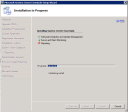I’ve been trying to play around with System Center to see how we can use it to monitor our web application solution (DB utilisation, bandwidth, web server CPU/RAM etc).
Having eventually got through all the issues regarding the pre-existing WSUS 3.0 setup, existing SSRS install etc I got to the ‘installing’ section. This section took an absolute age to run (20mins approx on a Xeon 3050 (2×2.13Ghz) with 2Gb RAM). It would run through “Software Distribution and Update Management”, then “Server and Client Monitoring”, and finally “Reporting”. However on Reporting it would just put a red X next to it, then appear to roll-back a bit and reboot the PC without prompting – NICE!
I looked for a while and couldn’t find any information about it until I stumbled across KB937831 which basically describes a problem which applies to our environment. Basically our domain is setup as follows:
Our company is called Xyz Ltd
Our public facing domain name is xyz.com
Our NETBIOS domain name is XYZ
Our Active Directory FQDN is internal.xyz.com
The issue appears to be that the installer makes an assumption that the first part of the FQDN is the NETBIOS name, which for us it isn’t. In this case it’s authenticating with the username INTERNAL\Administrator rather than XYZ\Administrator. The relevant part from the %TEMP%\ SCEReporting0.log file is:
UnableToGetUserNameFromManagementServerActionAccount = SetPropertiesToManagementServerActionAndSDKAccountCA error: Microsoft.EnterpriseManagement.Common.UnauthorizedAccessMonitoringException : The specified domain does not exist or cannot be contacted. UnableToGetUserNameFromManagementServerSDKAccount = SetPropertiesToManagementServerActionAndSDKAccountCA error: Microsoft.EnterpriseManagement.Common.UnauthorizedAccessMonitoringException : The specified domain does not exist or cannot be contacted.
The KB937831 says that the patch is only available via product support, however this isn’t true as it’s included in the roll-up available in KB943111.
UPDATE: it seems I was a bit premature, that roll-up doesn’t resolve the issue. There appear to be two relevant blog posts which point to how to get the HotFix via a web request form, I’m waiting my 8hours now…
http://blogs.technet.com/cliveeastwood/rss_tag_Bugs+or+Features_3F00_.xml
http://blogs.technet.com/smsandmom/archive/2007/09/13/sce2007-install-fails-with-the-specified-domain-does-not-exist-or-cannot-be-contacted.aspx




